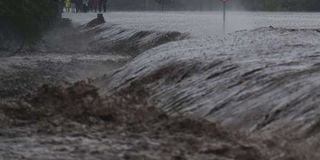World Bank report says climate change to hit East Africa hard

Flash floods in Isinya, Kajiado County, on March 15, 2018. PHOTO | TONY KARUMBA | AFP
What you need to know:
Report says areas suffering from sporadic and erratic rainfall, population stress and persistent crop failure could see large outflows of people.
The World Bank noted that Dar es Salaam, in particular, will experience dampened population growth.
Adding to the problem is East Africa’s rising population which could hit 786 million by 2050.
Climate change across East Africa could see more than 10 million people forced to move by 2050, according to a new World Bank report.
The hardest hit could be the coastal regions of Kenya and Tanzania, but the report says that any areas suffering from sporadic and erratic rainfall, population stress and persistent crop failure could see large outflows of people.
The World Bank noted that Dar es Salaam, in particular, will experience dampened population growth due to rising sea levels and storm surges.
LAKE VICTORIA BASIN
However, while coastal regions are likely to see a fall in population levels, there will be an increase in areas around the Lake Victoria basin and in the region’s major cities which are not on the coast.
These could rise by an additional 750,000 over existing projections during the next 30 years purely as a result of climate change.
The report, Groundswell – Preparing for Internal Climate Migration, is the first and most comprehensive study of its kind to focus on climate change impacts, internal migration patterns and development in three developing regions of the world: Sub-Saharan Africa, South Asia, and Latin America.
CLIMATE MIGRATION
Under all three scenarios in this report, there is an upward trend of internal climate migration by 2050.
In the worst-case or “pessimistic” scenario, the number of internal climate migrants could reach more than 143 million around 86 million of whom will be in Sub-Saharan Africa.
The poorest people and the poorest countries will be the hardest hit, the report says.
Adding to the problem is East Africa’s rising population which could hit 786 million by 2050.
TEMPERATURE RISE
The World Bank says that southern portions of East Africa have experienced a significant increase in temperature since the beginning of the early 1980s, but rainfall increases are deemed “very unlikely”.
The report says that rainfall variability puts stress on livelihood systems, ranging from pastoralism in the northern portions to subsistence farming and domestic livestock-keeping in the rest of the region.
It adds that rising temperatures and extremes are also putting stress on water availability and cropping systems.
World Bank Chief Executive Officer Kristalina Georgieva said the new research provides a wake-up call to countries and development institutions.
“We have a small window now, before the effects of climate change deepen, to prepare the ground for this new reality,” Georgieva said.





